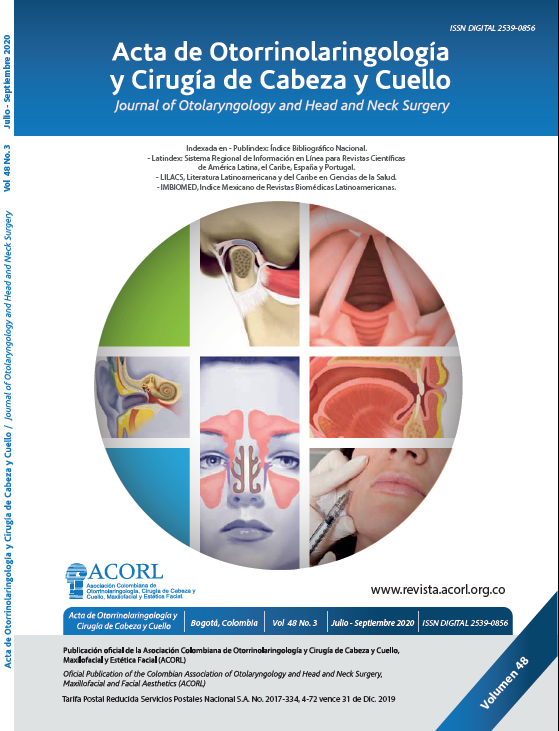Caracterización de la población que consulta por epistaxis al servicio de otorrinolaringología del Hospital Universitario Mayor Méderi (HUM)
Contenido principal del artículo
Resumen
Introducción: La epistaxis es uno de los principales motivos de consulta por urgencias en el servicio de Otorrinolaringología. La mayoría de los episodios se originan en el septo nasal anterior y su manejo tiende a ser conservador. Objetivo: Caracterizar la población que consulta por epistaxis al servicio de Otorrinolaringología del Hospital Universitario Mayor Méderi (HUM) entre marzo de 2017 y febrero de 2018. Metodología: Estudio observacional, descriptivo, de corte transversal, con recolección de datos de forma retrospectiva de pacientes que ingresan a urgencias del HUM por epistaxis, registrados en la base de datos del servicio de Otorrinolaringología. Se analizaron datos demográficos, localización del sangrado, tratamiento, comorbilidades, fármacos y cifras tensionales.
Detalles del artículo
Sección

Esta obra está bajo una licencia internacional Creative Commons Atribución-CompartirIgual 4.0.
Este artículo es publicado por la Revista Acta de Otorrinolaringología & Cirugía de Cabeza y Cuello.
Este es un artículo de acceso abierto, distribuido bajo los términos de la LicenciaCreativeCommons Atribución-CompartirIgual 4.0 Internacional.( http://creativecommons.org/licenses/by-sa/4.0/), que permite el uso no comercial, distribución y reproducción en cualquier medio, siempre que la obra original sea debidamente citada.
eISSN: 2539-0856
ISSN: 0120-8411
Cómo citar
Referencias
Bequignon E, Vérillaud B, Robard L, Michel J, Prulière Escabasse V, Crampette L, et al. Guidelines of the French
Society of Otorhinolaryngology (SFORL). First-line treatment of epistaxis in adults. Eur Ann Otorhinolaryngol Head Neck Dis. 2017;134(3):185-9. doi:10.1016/j.anorl.2016.09.008
Al-bar MH. Epistaxis and catastrophic nasal bleeding. OperTech Otolaryngol - Head Neck Surg. 2014;25(2):194-200. doi:10.1016/j.otot.2014.02.010
Davies K, Batra K, Mehanna R, Keogh I. Pediatric epistaxis:epidemiology, management & impact on quality of life. Int JPediatr Otorhinolaryngol. 2014;78(8):1294-97. doi:10.1016/j.ijporl.2014.05.013
Kasperek ZA, Pollock GF. Epistaxis: an overview. Emerg Med Clin North Am. 2013;31(2):443-454. doi:10.1016/j.
emc.2013.01.008
Kindler RM, Holzmann D, Landis BN, Ditzen B, Soyka MB. The high rate of long-term recurrences and sequelae after epistaxis treatment. Auris Nasus Larynx. 2016;43(4):412-7.doi:10.1016/j.anl.2015.09.011
Verillaud B, Robard L, Michel J, Pruliere Escabasse V, Béquignon E, et al. Guidelines of the French Society of
Otorhinolaryngology (SFORL). Second-line treatment ofepistaxis in adults. Eur Ann Otorhinolaryngol Head Neck Dis.2017;134(3):191-193. doi:10.1016/j.anorl.2016.09.009
Lin G, Bleier B. Surgical Management of Severe Epistaxis.Otolaryngol Clin North Am. 2016;49(3):627-37. doi:10.1016/j.otc.2016.01.003
Monjas-Cánovas I, Hernández-García I, Mauri-Barberá J, Sanz- Romero B, Gras-Albert JR. Epidemiología de las epistaxisingresadas en un hospital de tercer nivel. Acta OtorrinolaringolEsp. 2010;61(1):41–7.
Pallin DJ, Chng YM, McKay MP, Emond JA, Pelletier AJ,Camargo CA Jr. Epidemiology of epistaxis in US emergency departments, 1992 to 2001. Ann Emerg Med. 2005;46(1):77-81.doi:10.1016/j.annemergmed.2004.12.014
Viehweg TL, Roberson JB, Hudson JW. Epistaxis: diagnosis and treatment. J Oral Maxillofac Surg. 2006;64(3):511-518.doi:10.1016/j.joms.2005.11.031
Ando Y, Iimura J, Arai S, et al. Risk factors for recurrent epistaxis: importance of initial treatment. Auris Nasus Larynx.2014;41(1):41-45. doi:10.1016/j.anl.2013.05.004
Corr MJ, Tikka T, Douglas CM, Marshall J. One-year all-cause mortality for 338 patients admitted with epistaxis in a largetertiary ENT centre. J Laryngol Otol. 2019;133(6):487-493.doi:10.1017/S0022215119000860
Newton E, Lasso A, Petrcich W, Kilty SJ. An outcomes analysis of anterior epistaxis management in the emergency department. J Otolaryngol Head Neck Surg. 2016;45:24. doi:10.1186/s40463-016-0138-2
Kubba H, MacAndie C, Botma M, et al. A prospective, singleblind, randomized controlled trial of antiseptic cream for recurrent epistaxis in childhood. Clin Otolaryngol Allied Sci.2001;26(6):465-468. doi:10.1046/j.1365-2273.2001.00502.x
Abrich V, Brozek A, Boyle TR, Chyou PH, Yale SH. Risk factors for recurrent spontaneous epistaxis. Mayo Clin Proc. Acta de Otorrinolaringología & Cirugía de Cabeza y Cuello. 2020; 48(3): 44(2): 92-99 33 2014;89(12):1636-1643. doi:10.1016/j.mayocp.2014.09.009
Terakura M, Fujisaki R, Suda T, Sagawa T, Sakamoto T.Relationship between blood pressure and persistent epistaxis at the emergency department: a retrospective study. J Am Soc Hypertens. 2012;6(4):291-295. doi:10.1016/j.jash.2012.05.001
Lubianca Neto JF, Fuchs FD, Facco SR, et al. Is epistaxis evidence of end-organ damage in patients with
hypertension?. Laryngoscope. 1999;109(7 Pt 1):1111-15.doi:10.1097/00005537-199907000-00019
Min HJ, Kang H, Choi GJ, Kim KS. Association between Hypertension and Epistaxis: Systematic Review and Metaanalysis. Otolaryngol Head Neck Surg. 2017;157(6):921-927.doi:10.1177/0194599817721445





